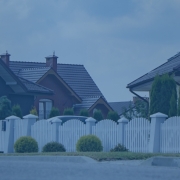Financing New Construction vs. Existing Homes: Pros and Cons

Popular Loan Options for Financing an Existing Property
Let’s first look at the most common type of mortgage: financing an existing property. Financing an existing mortgage offers a lot more loan options compared to a loan to finance a new construction for a brand new home. Pretty much every available loan program is available for these types of purchases. There are fixed rate loans and adjustable rate loans. Fixed rate programs are those where the rate never changes and therefore the monthly payment never changes. For the risk-averse, a fixed rate loan is the better choice. Borrowers know in advance that the monthly payment 20 or 30 years down the road will be the very same as from day one.
Fixed Rate Mortgages
Fixed rate mortgages are offered in loan terms from 10 to 30 years, in five year increments. The 30 year term is arguably the most popular because it stretches the payments out over a longer period resulting in a lower monthly payment and easier qualifying. A few loan programs are offered with loan terms up to 40 years, although these loans fall into the “non-QM” and portfolio category. A 10 year term means a higher monthly payment but the savings in long term interest with a 10 year term is substantial.
Adjustable Rate Mortgages
Adjustable rate mortgages, commonly referred to as ARMs, can have the rate change at various points in the future. However, when a rate changes, the way it can change is known at the initial settlement table. An ARM rate is based upon a selected index and a margin is added to that index. There are also rate caps which limit how much the rate is allowed to change at each adjustment period as well as over the life of the loan.
Financing New Construction: How it Works
A mortgage designed for an existing home cannot be used to finance new construction, however. Loans designed to finance a new home are different. These loans, construction loans, are typically only for the time it takes to build the home. If a home is scheduled to be completed in 12 months, then a 12 month construction loan will be the choice.
Lenders will want to see the building plans and specifications for the project and after such a review, the lender will establish a draw schedule which will pay the builder money in stages as each phase of the home is completed. A schedule might include draws for clearing the lot, pouring the foundation, electrical and plumbing and so on. Unlike financing an existing home, there are no longer term financing options such as a 15 or 30 year loan.
When the home is completed, the lender sends out an inspector one last time to make sure the home has been 100% completed and ready for occupancy. At this point, the construction loan needs to be replaced by a permanent mortgage, one that is reserved for an existing property. One thing to note, during construction, interest rates can and will change over time. If someone starts to build a home in January and the home is scheduled for completion in December, buyers won’t be able to lock in a rate in January for a December closing. Instead, the rate must be locked prior to the closing but closer to the settlement date. Most programs allow for buyers to lock in a rate anywhere from 30 to 60 days out.
One-Time-Close Options
To avoid the uncertainty about where rates might be one year away, there are also “one time close” loan programs where the new loan finances the construction as well as guarantees a permanent mortgage and rate at the initial settlement table. This takes the guesswork out of where rates will be in the future while providing some peace of mind. One side note, the permanent mortgage rate for these programs are typically higher than what the prevailing permanent rates will be.
You do have options between buying an existing property compared to building new, but once you do make that decision, there are just a few more you’ll need to make.



